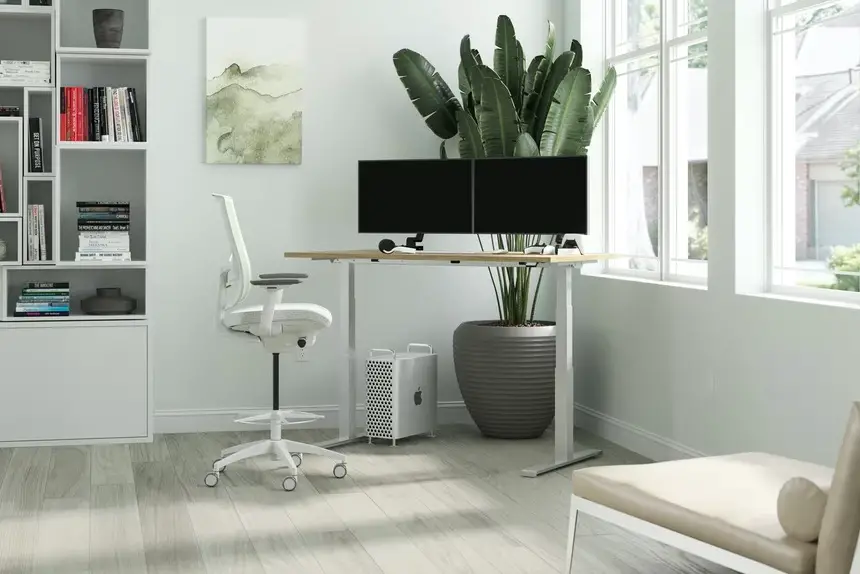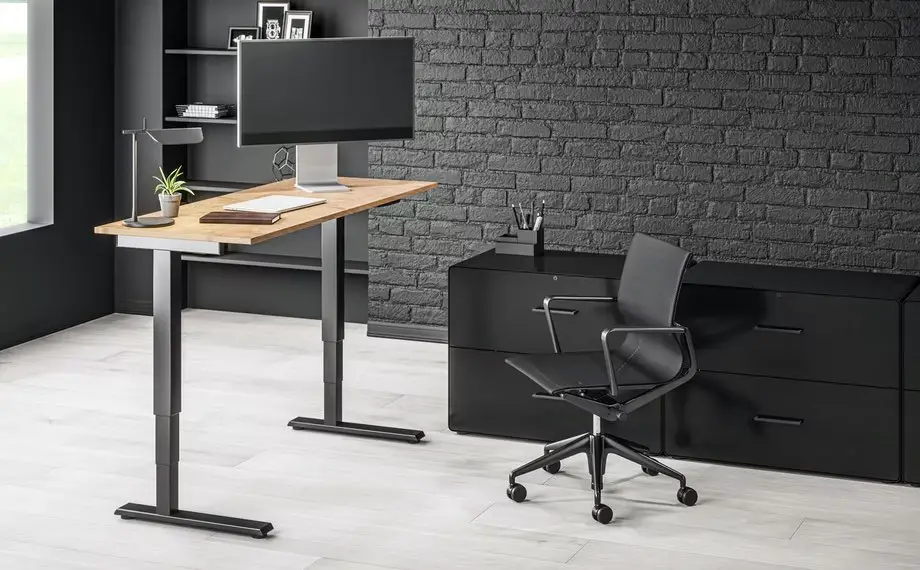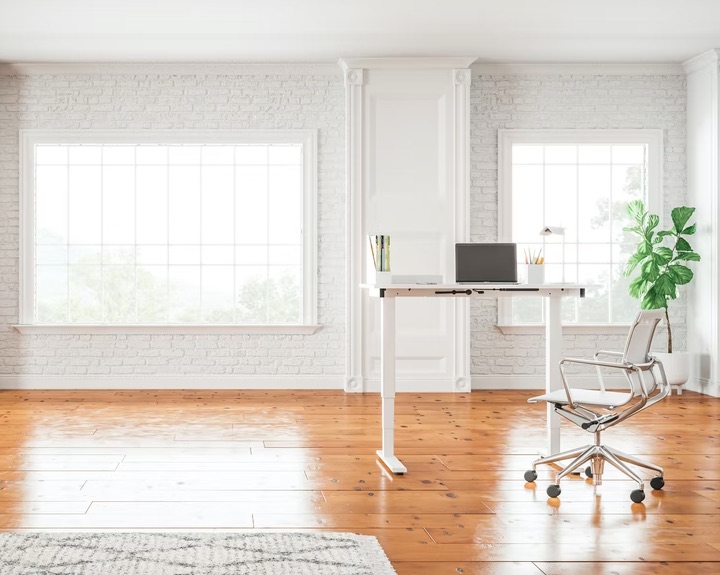Sit-stand desks are increasingly popular in workplaces, offering the flexibility to switch between sitting and standing throughout the day. Sit-stand desks significantly benefit health, productivity, and overall well-being by allowing this adjustment.
Below, we discuss the key advantages of sit-stand desks, explaining how they can positively impact health and workplace efficiency.
Let's get straight to the point
Sit-stand desks offer substantial health, productivity, and well-being benefits by allowing workers to alternate between sitting and standing. They help reduce cardiovascular risks, obesity, back pain, and cancer while promoting better posture and mental clarity.
Using these desks boosts caloric burn, supports weight management, and fosters an active lifestyle even in sedentary jobs. Improved focus, mood, energy levels, and circulation lead to higher employee satisfaction and less absenteeism.
Overall, sit-stand desks create a health-conscious work environment supporting long-term health and productivity.
1. Improved Physical Health

Using a sit-stand desk helps combat the negative effects of prolonged sitting, which is linked to various health concerns such as cardiovascular disease, obesity, and musculoskeletal issues. Alternating between sitting and standing allows users to stay more active throughout the day.
- Reduced Cardiovascular Risks: Sitting for extended periods can decrease blood flow, increasing the risk of heart disease. Standing periodically promotes circulation, reducing this risk.
- Lower Risk of Obesity: Standing burns more calories than sitting, helping to maintain a healthier weight. Standing for three hours daily could burn an additional 30,000 calories a year.
- Decreased Risk of Type 2 Diabetes: Studies show that standing more often improves insulin effectiveness and helps control blood glucose levels.
- Reduced Cancer Risk: Prolonged sitting has been linked to certain cancers. Using a sit-stand desk can decrease the risks associated with sedentary behaviour, particularly colon and breast cancers.
2. Increased Caloric Expenditure And Weight Management
Switching to a sit-stand desk can support weight management. Standing rather than sitting boosts caloric burn, assisting in weight control and potentially preventing obesity.
- More Calories Burned: Standing uses more energy than sitting. While standing may only burn 100-200 calories per hour compared to sitting at 60-130, these differences add up over a workday.
- Encourages Movement: Sit-stand desks allow for micro-movements, such as shifting weight from one leg to another, stretching, or stepping away briefly, increasing energy expenditure.
- Supports Active Lifestyle Goals: A sit-stand desk can help meet daily activity goals without requiring intense exercise sessions for those struggling to stay active in sedentary jobs.
3. Enhanced Productivity And Focus
Sit-stand desks have shown a positive impact on productivity and concentration. Standing increases blood flow to the brain, keeping workers alert and focused on their tasks.
- Boosted Mental Clarity: Standing increases oxygen flow to the brain, leading to better focus and improved cognitive performance.
- Higher Engagement: Being on one’s feet promotes engagement. Many users report that standing helps them feel more involved in their work, especially during meetings and brainstorming sessions.
- Reduced Fatigue: Alternating between sitting and standing can help prevent the physical exhaustion of sitting all day, leading to sustained energy levels.
4. Better Posture And Reduced Back Pain
Sit-stand desks allow for a more ergonomic workspace, improving posture and reducing the risk of musculoskeletal issues such as neck, shoulder, and back pain. Sitting for long hours often encourages slouching, leading to poor posture over time.
- Spinal Alignment: Standing allows users to keep their spine neutral, reducing strain on the lower back.
- Less Pressure on Neck and Shoulders: With screens adjusted at eye level, a sit-stand desk helps avoid the forward head posture common with prolonged sitting.
- Minimised Lower Back Pain: Standing can alleviate lower back pain that often results from poor posture in seated positions, making it an effective solution for people with chronic pain.
5. Positive Impact On Mood And Energy Levels
The flexibility of a sit-stand desk can help prevent the mental and emotional fatigue associated with being sedentary, positively affecting mood and energy.
- Higher Energy Levels: Standing at intervals throughout the day helps to reduce feelings of lethargy and boosts overall energy.
- Better Mood: Studies show that people who use sit-stand desks report higher job satisfaction and better mood due to improved physical comfort and activity levels.
- Lower Stress and Anxiety: Regular movement improves mental resilience and can alleviate stress, contributing to a better workplace environment.
6. Prevention Of Long-Term Health Risks
Sit-stand desks not only provide immediate health benefits but also serve as a preventive measure against long-term health risks. Sedentary lifestyles are increasingly linked to serious conditions that can affect longevity.
- Reduced Risk of Metabolic Syndrome: Sitting for long periods is a significant risk factor for metabolic syndrome, a group of conditions increasing the risk of heart disease and diabetes.
- Lowered Cancer Risks: Prolonged sitting is associated with higher risks of certain cancers, as noted in studies linking sedentary behaviour with colon and endometrial cancers.
- Enhanced Longevity: Incorporating more standing time into daily routines can have long-term health benefits, potentially increasing life expectancy by promoting a more active lifestyle.
7. Flexibility To Adjust Between Tasks

A sit-stand desk offers the versatility to adapt to different tasks, providing ergonomic benefits for various activities.
- Convenient Adjustments for Task-Specific Needs: Standing may be ideal for certain tasks, like making phone calls or attending virtual meetings, while seated work might be better for tasks requiring focused attention, such as detailed typing or design work.
- Memory Features for Easy Adjustment: Many high-end sit-stand desks offer memory settings that allow users to switch between pre-set heights, making it simple to alternate positions quickly and without disruption.
- Supports Different Work Styles: Sit-stand desks cater to diverse work needs, making it possible to tailor the desk height to specific activities. Thus, they support both physical health and productivity.
8. Improved Circulation And Reduced Risk Of Blood Clots
Standing throughout the day promotes blood circulation, which is essential for preventing conditions like deep vein thrombosis (DVT) associated with prolonged sitting.
- Better Blood Flow: Alternating between sitting and standing promotes circulation throughout the body, preventing blood from pooling in the legs and reducing the risk of clot formation.
- Reduced Pressure on Veins: Regularly standing helps relieve pressure on veins, lowering the risk of varicose veins and other circulation issues.
- Healthier Cardiovascular System: Improved circulation contributes to overall heart health, reducing the risk of heart disease and other cardiovascular conditions.
9. Caloric Burn For Weight Loss
While standing alone isn’t a replacement for regular exercise, the additional caloric burn from standing rather than sitting contributes to weight management goals over time.
- Steady Calorie Burn: Standing for three hours daily can burn an estimated 750 extra calories per week. This extra calorie burn may not result in immediate weight loss but contributes to healthier weight management.
- Encourages Regular Movement: Sit-stand desks encourage users to shift positions or step away briefly, leading to even more calories burned throughout the day.
- Supports Metabolic Health: Regular standing has been shown to positively impact metabolic rates, helping to prevent metabolic disorders over the long term.
10. Fosters A Health-Conscious Work Environment
Sit-stand desks are becoming a popular choice in workplaces that prioritise employee well-being. By supporting healthier habits, these desks foster a health-conscious work environment that benefits employees and employers.
- Increased Employee Satisfaction: Employees who feel that their health is supported at work report higher levels of job satisfaction.
- Reduced Absenteeism: Healthier work habits help reduce musculoskeletal pain and fatigue, leading to lower absenteeism rates.
- Enhanced Company Image: Companies that invest in sit-stand desks and other ergonomic furniture can build a positive reputation for caring about employee wellness.
Conclusion
Incorporating sit-stand desks into the workplace offers numerous benefits for health, productivity, and overall well-being.
By allowing employees to alternate between sitting and standing, they reduce the health risks associated with prolonged sitting, such as cardiovascular disease, obesity, and back pain.
These desks support better posture, energy levels, and focus and contribute to long-term health by helping prevent conditions like metabolic syndrome and certain cancers.
For organisations, adopting sit-stand desks can lead to higher employee satisfaction, reduced absenteeism, and a health-conscious work environment, making it a valuable, sustainable choice for a more productive and engaging workplace.
FAQs About Desk
Standing desks seem to help ease back pain, but doctors don't know how much time you need to stand to get this benefit. More productive: In a study of call center employees, those with standing desks were 45% more productive on a daily basis than employees who sat during their shift.
Many ergonomic experts recommend standing about 5-15 minutes out of every hour when using a standing desk, although research is ongoing. One study in the British Journal of Sports Medicine recommends that it's ideal to move, stand, and take breaks from sitting for a total of at least 2 hours in an 8 hour work day.
Sitting behind your desk all day is bad for your health and experts have long been advising people to stand at their workstations for about 15 minutes an hour. But a University of Waterloo professor says his research shows that people should be standing for at least 30 minutes per hour to get health benefits.
That means for every 1 to 2 hours you sit in your office, 1 hour should be spent standing. Try to alternate between sitting and standing every 30 to 60 minutes.
Standing is better for the back than sitting. It strengthens leg muscles and improves balance. It burns more calories than sitting. It is also a great antidote to the formation of blood clots deep in the legs.

